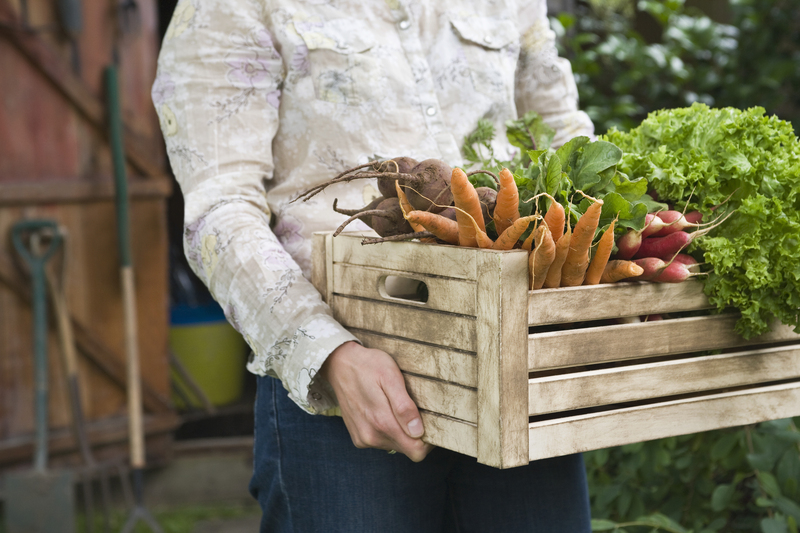Rain or Shine: Keeping Your Garden Safe from the Elements
Posted on 03/09/2025
Rain or Shine: Keeping Your Garden Safe from the Elements
Every gardener dreams of lush, vibrant plants and a thriving backyard. But, whether it's scorching sunlight, heavy rainfall, or strong winds, unpredictable weather can seriously threaten your garden's health. In this comprehensive guide, we'll explore practical strategies and expert advice for keeping your garden safe from the elements, so you can enjoy beautiful blossoms and bountiful harvests all year long.

Why Protecting Your Garden from the Elements Matters
The environment plays a huge role in the success of your garden. Exposure to extreme elements--rain, sun, wind, frost, and hail--can stress plants, stunt growth, and even cause total crop failure. By understanding the challenges nature presents, you can implement smart solutions to ensure your garden remains healthy--rain or shine.
Key Weather Hazards for Gardens
- Heavy Rain: Causes soil erosion, nutrient runoff, and root rot.
- Drought and Sun Exposure: Leads to dehydration, sunburn, leaf scorch, and weak plants.
- Wind: Can uproot seedlings, damage branches, and increase evaporation.
- Hail: Breaks leaves and stems, bruises fruit and flowers.
- Frost and Cold: Damages tender plants, inhibits growth, or even kills sensitive species.
Strategies for Weatherproofing Your Garden
With a combination of proactive planning and smart gardening techniques, you can minimize weather-related damage and keep your garden flourishing whatever Mother Nature brings.
1. Improving Garden Drainage for Rain Protection
Heavy rain and flooding are two of the biggest threats to your garden. Without proper drainage, water accumulates, drowning roots and fostering disease. Here's how to guard your garden:
- Elevated Beds: Raised garden beds ensure better water management and prevent standing water, especially for sensitive plants.
- Soil Amendment: Mix organic matter like compost with sand or perlite to help loosen clay soils, increasing permeability.
- French Drains: Install gravel-filled trenches alongside your beds to divert excess water away.
- Mulching: Spread a thick layer of organic mulch to slow rainfall impact, absorb water, and prevent erosion.
2. Shielding Plants from Excessive Sun
While most plants love the sun, too much of it--especially during heatwaves--can be hazardous. When keeping your garden safe from the elements, protecting your plants against sunburn and dehydration is vital.
- Shade Cloth: Use shade netting or cloths to block intense midday rays, reducing heat stress by up to 50%.
- Proper Watering: Water early in the day to minimize evaporation--focus on root zones, not foliage.
- Mulch: Retain soil moisture and regulate temperature naturally. Organic mulches like straw, leaves, or bark chips are most effective.
- Windbreaks: Trees, shrubs, or fences not only guard against wind but also create natural shade in exposed areas.
3. Protecting Against Strong Winds
High winds wreak havoc in the garden by toppling young plants and stripping leaves. To minimize wind damage, try these tips:
- Plant Windbreaks: Dense hedges, evergreen trees, or sturdy fencing shield sensitive beds from prevailing winds.
- Staking: Stake tall or top-heavy plants, like tomatoes or dahlias, for extra support in stormy weather.
- Row Covers: Lightweight fabric row covers protect delicate greens without suffocating them.
- Effective Garden Design: Arrange plants in staggered rows and place taller species upwind to shelter fragile varieties.
4. Preventing Hail Damage
Hailstorms can obliterate your garden in moments. To avert disaster, consider the following:
- Temporary Covers: Store lightweight frost cloths, tarps, or garden fabric in your shed and deploy them during hail forecasts.
- Protective Structures: Erect low tunnels, greenhouses, or hoop houses for the most susceptible plants.
- Mesh Netting: String heavy-duty nets above beds to diffuse hail impact without blocking light.
5. Defending Plants Against Frost and Cold
Frost is a silent killer, especially for warm-season crops. Stay ahead with these tips:
- Frost Blankets: Cover sensitive plants overnight with frost cloth or even old bed sheets.
- Mulch Insulation: Add a thick layer of straw or leaves around roots to trap heat in the soil.
- Greenhouses and Cold Frames: Use these for year-round growing and maximum cold protection.
- Water Wisely: Surprisingly, moist soil retains heat better--water roots thoroughly before a predicted frost.
Additional Weatherproof Gardening Techniques
Soil Health is Key
Healthy soil is resilient soil. By investing in regular composting and soil testing, you'll give your plants the best possible chance against extreme weather events. Good soil structure aids drainage, root growth, and drought resistance.
Choosing Weather-Resilient Plants
- Drought-tolerant Species: Lavender, sedum, echinacea, and ornamental grasses thrive with less water.
- Flood-resistant Plants: Irises, marsh marigolds, and sweet flag can handle waterlogged soils.
- Wind-hardy Choices: Juniper, boxwood, and holly are tough enough for exposed gardens.
- Frost-resistant Varieties: Kale, spinach, and pansies endure chilly nights with ease.
Smart Plant Arrangement
Group plants with similar weather requirements together. Shade lovers should be tucked behind sun-loving species or under the canopy of taller plants. This not only increases visual interest but also uses microclimates to your advantage for natural element protection.
Install Water Management Systems
- Drip Irrigation: Delivers water precisely where roots need it, minimizing evaporation in hot or windy weather.
- Rain Barrels: Collecting rainwater ensures sustainable watering during dry spells and prevents runoff during storms.
- Permeable Pathways: Using gravel or spaced pavers allows rainwater to soak where it's needed rather than washing away topsoil.
Monitor and Respond to Weather Conditions
Stay informed with weather apps or local gardening networks, so you can act quickly when conditions change. Always keep a garden emergency kit--stakes, row covers, and mulch--on hand for rapid response.
Year-Round Tips for Keeping Your Garden Safe from the Elements
Spring
- Prepare beds with extra compost for vigorous growth after winter.
- Install windbreaks and plan for sudden temperature drops.
- Watch for late frosts - keep row covers ready.
Summer
- Mulch heavily to conserve soil moisture and regulate temperature.
- Water early in the morning or late in the day to prevent evaporation.
- Shade delicate plants during prolonged heatwaves.
Autumn
- Plant cover crops to protect and enrich soil for the coming year.
- Remove spent annuals and clean up debris to limit disease spread from extended wet weather.
- Continue to water as needed, especially for new plantings.
Winter
- Use frost blankets and cloches for perennials and vulnerable beds.
- Pile mulch around shrubs and roses for root insulation.
- Regularly check greenhouses for drafts and adequate humidity.
How to Create a Microclimate in Your Garden
Microclimates--small areas with specific temperature, moisture, and wind conditions--are your best allies in weatherproof gardening. Walls, fencing, water features, and even garden art can create sheltered spots where tender or exotic specimens thrive.
- South-Facing Walls: Plant heat-loving crops like tomatoes or peppers here for extra warmth.
- Ponds and Water Features: Moderate high temperatures and increase ambient humidity.
- Dense Planting: Tight plant groupings shield roots and soil from sun and reduce evaporation.
- Moveable Containers: Grow sensitive plants in pots you can relocate according to the weather.
Key Tools and Supplies for Garden Weather Protection
- Mulch (organic and inorganic)
- Frost cloths, garden fleece, and row covers
- Stakes, cages, and trellises
- Shade netting or pergolas
- Watering cans, hoses, and irrigation systems
- Rain barrels
- Protective structures (greenhouses, cold frames, hoop houses)

Frequently Asked Questions About Keeping Your Garden Safe from the Elements
Is mulch really necessary for weatherproofing my garden?
Absolutely! Mulch is one of your best defenses against both excessive rain and hot sun. It stabilizes moisture, prevents sudden temperature swings, and suppresses weeds, making your garden more resilient during climate extremes.
Can I grow vegetables year-round despite the weather?
Yes! With the right infrastructure--like greenhouses, cold frames, and frost covers--you can grow many vegetables throughout the year. Opt for hardy crops in winter (kale, broccoli, carrots), and use shade or wind protection for summer veggies during peak heat.
How can I quickly protect my plants during an unexpected storm?
Keep lightweight garden fleece, tarps, or buckets in your shed. Cover plants at the first sign of hail, high wind, or frost. Stake taller plants in advance and use secure, breathable materials that don't trap excess moisture.
What if heavy rains are flooding my garden beds?
First, check that your beds are slightly raised and not in a low-lying area. Apply more mulch, clean out blocked drains, and consider installing French drains or redirecting runoff with landscaping solutions.
Conclusion: Enjoy a Healthy, Flourishing Garden--No Matter the Weather!
While you can't control the weather, you can take proactive steps for keeping your garden safe from the elements. By improving soil health, selecting resilient plants, investing in protective gear, and responding swiftly to forecasts, your garden will thrive rain or shine. Remember that staying informed and prepared is half the battle.
Apply these strategies today and watch your outdoor space become an all-season sanctuary! With care, foresight, and a little help from Mother Nature, you'll enjoy gardening success for years to come.



